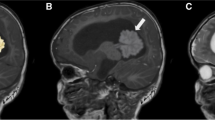Abstract
Infantile myofibromatosis is a rare and nonmalignant pediatric tumor of myofibroblastic origin that may occur in solitary or multifocal forms. Soft tissue of the head and neck, trunk, and extremities, skeleton, and viscera are usually involved. Intracranial involvement is reported to be extremely rare, and its clinical picture has been poorly characterized. We present two cases of giant infantile myofibromatosis of the skull base with intracranial involvement. The first case with prenatal diagnosis involved extensively the extradural space of the occipital region and was previously treated by chemotherapy for a previous diagnosis of hemangioperycitoma. Tumor was removed at the age of 5 months and no recurrence was observed during the 3-year follow-up. The second case in a 2-year-old baby involved the anterior cranial base, the nasal cavity, the right orbit, and presented massive involvement of the anterior cranial fossa. Surgery allowed complete removal and a recurrence-free period of 7 years after surgery. Treatment options for these unusual cases are presented and details of histological diagnosis are discussed.




Similar content being viewed by others
References
Coffin CM, Alaggio R (2012) Fibroblastic and myofibroblastic tumors in children and adolescents. Pediatr Dev Pathol. 15(1 Suppl):127–80
Narchi H (2001) Four half-siblings with infantile myofibromatosis: a case for autosomal-recessive inheritance Clin Genet 59(2):134–5
Zand DJ, Huff D, Everman D, Russell K, Saitta S, McDonald-McGinn D et al (2004) Autosomal dominant inheritance of infantile myofibromatosis. Am J Med Genet A 126A(3):261–6. Review. PubMed PMID: 15054839
Kaplan SS, Ojemann JG, Grange DK, Fuller C, Park TS (2002) Intracranial infantile myofibromatosis with intraparenchymal involvement. Pediatr Neurosurg 36(4):214–7. PubMed PMID: 12006757
Ketcham AS, Wilkins RH, Vanburen JM, Smith RR (1963) A combined intracranial facial approach to the paranasal sinuses. Am J Surg 106:698–703. PubMed PMID: 14078719
Leon-Villapalos J, Wolfe K, Calonje E, Kangesu L (2007) Involuting solitary cutaneous infantile myofibroma and thrombocytopaenia: a previously unreported clinical association. J Plast Reconstr Aesthet Surg 60(11):1260–1262. Epub 2006. PubMed PMID: 17950191
Martín JM, Jordá E, Calduch L, Monteagudo C, Pereda C, Villalón G (2008) Self-healing generalized infantile myofibromatosis. J Eur Acad Dermatol Venereol 22(2):236–238. https://doi.org/10.1111/j.1468-3083.2007.02292.x. PubMed PMID:18211420
Inoue M, Tanaka S, Nakatomi H, Takayanagi S, Takahashi M, Tanaka M et al (2016) Intracranial infantile myofibromatosis mimicking malignant brain tumor: a case report and literature review. World Neurosurg 93:487:e15–20. https://doi.org/10.1016/j.wneu.2016.06.105. Epub 2016 Jun 30. PubMed PMID: 27373934
Miwa T, Oi S, Nonaka Y, Tamogami R, Sasaki H, Akiyama M et al (2011) Rapid spontaneous regression of multicentric infantilemyofibromatosis in the posterior fossa and lumbar vertebra. Childs Nerv SystMar 27(3):491–6. https://doi.org/10.1007/s00381-010-1306-8. Epub 2010. PubMed PMID: 20949273
Tamburrini G, Gessi M, Colosimo C Jr, Lauriola L, Giangaspero F, Di Rocco C (2003) Infantile myofibromatosis of the central nervous system. Childs Nerv Syst 19(9):650–654. Epub 2003. PubMed PMID: 12720031
Zhang X, Tabani H, El-Sayed I, Russell M, Feng X, Benet A (2017) The endoscopic endonasal transmaxillary approach to Meckel’s cave through the inferior orbital fissure. Oper Neurosurg (Hagerstown) 13(3):367–373. https://doi.org/10.1093/ons/opx009. PubMed PMID: 28521351
Agaimy A, Bieg M, Michal M, Geddert H, Märkl B, Seitz J et al (2017) Recurrent somatic PDGFRB mutations in sporadic infantile/solitary adult myofibromas but not in angioleiomyomas and myopericytomas. Am J Surg Pathol 41(2):195–203. https://doi.org/10.1097/PAS.0000000000000752. PubMed PMID: 27776010
Arts FA, Sciot R, Brichard B, Renard M, de Rocca Serra A, Dachy G et al (2017) PDGFRB gain-of-function mutations in sporadic infantile myofibromatosis. Hum Mol Genet May 15;26(10):1801–1810. https://doi.org/10.1093/hmg/ddx081. PubMed PMID: 28334876
Arts FA, Chand D, Pecquet C, Velghe AI, Constantinescu S, Hallberg B et al (2016) PDGFRB mutants found in patients with familial infantile myofibromatosis or overgrowth syndrome are oncogenic and sensitive to imatinib. Oncogene Jun 23;35(25):3239–48. https://doi.org/10.1038/onc.2015.383. Epub 2015 PubMed PMID:26455322
Cheung YH, Gayden T, Campeau PM, LeDuc CA, Russo D, Nguyen VH et al (2013) A recurrent PDGFRB mutation causes familial infantile myofibromatosis. Am J Hum Genet Jun 6;92(6):996–1000. https://doi.org/10.1016/j.ajhg.2013.04.026. Epub 2013 May 23. PubMed PMID: 23731537; PubMedCentral PMCID: PMC3675240.
Galassi E, Pasquini E, Frank G, Marucci G (2008) Combined endoscopy-assisted cranionasal approach for resection of infantile myofibromatosis of the ethmoid and anterior skull base. Case report. J Neurosurg Pediatr 2(1):58–62. https://doi.org/10.3171/PED/2008/2/7/058. PubMed PMID: 18590397
Josephson GD, Patel S, Duckworth L, Goldstein J (2010) Infantile myofibroma of the nasal cavity; a case report and review of the literature. Int J Pediatr Otorhinolaryngol 74(12):1452–4. https://doi.org/10.1016/j.ijporl.2010.09.015. Epub2010 Review. PubMed PMID: 20950870
Mudry P, Slaby O, Neradil J, Soukalova J, Melicharkova K, Rohleder O et al (2017) Case report: rapid and durable response to PDGFR targeted therapy in a child with refractory multiple infantile myofibromatosis and a heterozygous germline mutation of the PDGFRB gene. BMC Cancer 10;17(1):119. https://doi.org/10.1186/s12885-017-3115-x. PubMed PMID: 28183292; PubMed Central PMCID: PMC5301362
Pond D, Arts FA, Mendelsohn NJ, Demoulin JB, Scharer G, Messinger Y (2018) A patient with germ-line gain-of-function PDGFRB p.N666H mutation and marked clinical response to imatinib. Genet Med 20(1):142–150. https://doi.org/10.1038/gim.2017.104. Epub 2017. PubMed PMID: 28726812
Weller JM, Keil VC, Gielen GH, Herrlinger U, Schäfer N (2019) PDGRFB mutation-associated myofibromatosis: response to targeted therapy with imatinib. Am J Med Genet A 179(9):1895–1897. https://doi.org/10.1002/ajmg.a.61283. Epub 2019. PubMed PMID: 31291054
Author information
Authors and Affiliations
Corresponding author
Ethics declarations
Conflict of interest
The authors report no conflict of interest concerning the materials or methods used in this study or the findings specified in this paper.
Additional information
Publisher's Note
Springer Nature remains neutral with regard to jurisdictional claims in published maps and institutional affiliations.
Rights and permissions
About this article
Cite this article
De Martino, L., Tresserras-Giné, G., Quaglietta, L. et al. Giant intracranial infantile myofibromatosis of the skull base: report of two cases. Childs Nerv Syst 38, 837–841 (2022). https://doi.org/10.1007/s00381-021-05271-z
Received:
Accepted:
Published:
Issue Date:
DOI: https://doi.org/10.1007/s00381-021-05271-z




